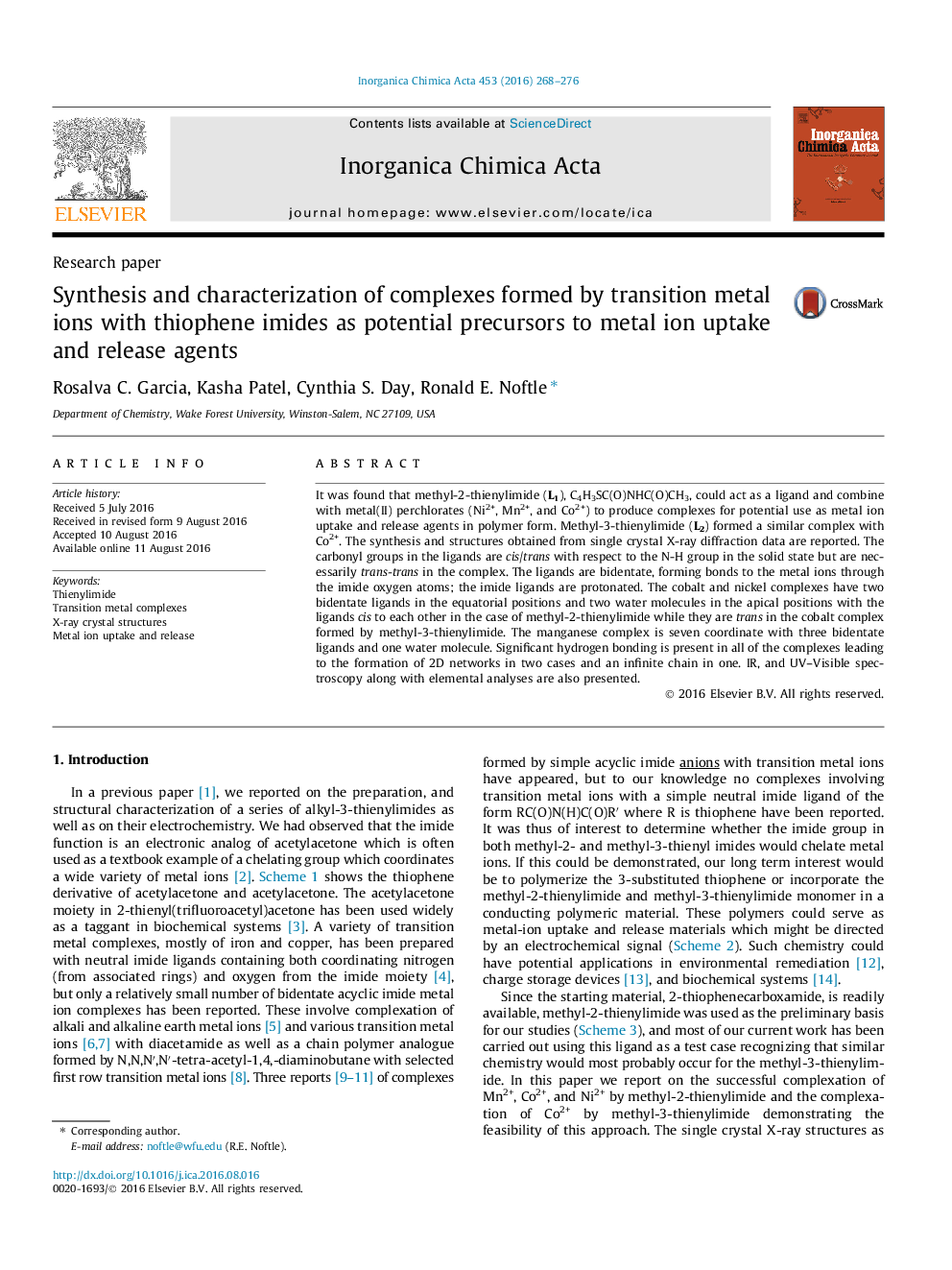| کد مقاله | کد نشریه | سال انتشار | مقاله انگلیسی | نسخه تمام متن |
|---|---|---|---|---|
| 1307431 | 1499136 | 2016 | 9 صفحه PDF | دانلود رایگان |
• Thienylimides form metal ion complexes via carbonyl bonding with intact NH group.
• 6-Coordinate Ni(II) and Co(II) with equatorial imide ligands and apical waters.
• Mn(II) complex is a seven-coordinate distorted pentagonal bipyramid of oxygen atoms.
• Thiophene rings in the Ni(II) and Co(II) complexes are cis while trans for Co(II).
• Potential electrochemical metal ion uptake/release film via conducting poly thiophene.
It was found that methyl-2-thienylimide (L1), C4H3SC(O)NHC(O)CH3, could act as a ligand and combine with metal(II) perchlorates (Ni2+, Mn2+, and Co2+) to produce complexes for potential use as metal ion uptake and release agents in polymer form. Methyl-3-thienylimide (L2) formed a similar complex with Co2+. The synthesis and structures obtained from single crystal X-ray diffraction data are reported. The carbonyl groups in the ligands are cis/trans with respect to the N-H group in the solid state but are necessarily trans-trans in the complex. The ligands are bidentate, forming bonds to the metal ions through the imide oxygen atoms; the imide ligands are protonated. The cobalt and nickel complexes have two bidentate ligands in the equatorial positions and two water molecules in the apical positions with the ligands cis to each other in the case of methyl-2-thienylimide while they are trans in the cobalt complex formed by methyl-3-thienylimide. The manganese complex is seven coordinate with three bidentate ligands and one water molecule. Significant hydrogen bonding is present in all of the complexes leading to the formation of 2D networks in two cases and an infinite chain in one. IR, and UV–Visible spectroscopy along with elemental analyses are also presented.
It was found that methyl-2-thienylimide (L1), C4H3SC(O)NHC(O)CH3, could act as a ligand and combine with metal(II) perchlorates (Ni2+, Mn2+, and Co2+) to produce complexes for potential use as metal ion uptake and release agents in polymer form. Methyl-3-thienylimide (L2) formed a similar complex with Co2+. The synthesis and structures obtained from single crystal X-ray diffraction data are reported. The carbonyl groups in the ligands are cis/trans with respect to the N-H group in the solid state but are necessarily trans-trans in the complex. The ligands are bidentate, forming bonds to the metal ions through the imide oxygen atoms; the imide ligands are protonated. The cobalt and nickel complexes have two bidentate ligands in the equatorial positions and two water molecules in the apical positions with the ligands cis to each other in the case of methyl-2-thienylimide while they are trans in the cobalt complex formed by methyl-3-thienylimide. The manganese complex is seven coordinate with three bidentate ligands and one water molecule. Significant hydrogen bonding is present in all of the complexes leading to the formation of 2D networks in two cases and an infinite chain in one. IR, and UV–Visible spectroscopy along with elemental analyses are also presented.Figure optionsDownload as PowerPoint slide
Journal: Inorganica Chimica Acta - Volume 453, 1 November 2016, Pages 268–276
